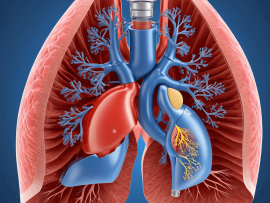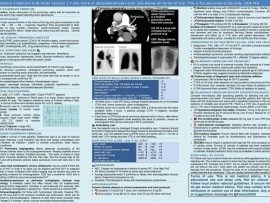Abstract There are limited data on the use of extracorporeal membrane oxygenation (ECMO) in high-risk pulmonary embolism (PE) patients. We analyzed the use of ECMO in high-risk PE patients (defined..
Read MoreAbstract Rapid hemodynamic stabilization and restoration of pulmonary perfusion are the cornerstones of treatment for high-risk pulmonary embolism (PE). While all current guidelines recommend systemic thrombolysis (SYS) as the first-line..
Read MoreAbstract PULMONARY EMBOLISM (PE) remains a significant healthcare challenge, ranking as the third leading cause of mortality worldwide, following coronary artery disease and stroke. In the United States, mortality rates among..
Read MoreAbstract In massive pulmonary embolism (PE), endovascular therapies and extracorporeal membrane oxygenation (ECMO) are increasingly utilised. However, the impact of combining endovascular therapies with ECMO on shock resolution and clinical recovery remains..
Read MoreAbstract We read with great interest the recent study by Stadlbauer et al. [1] published in Intensive Care Medicine, which evaluates the impact of reperfusion therapy including systemic thrombolysis (SYS), surgical..
Read MoreAbstract Aims The role of extracorporeal membrane oxygenation (ECMO) remains ill defined in pulmonary embolism (PE). We investigated outcomes in patients with high-risk PE undergoing ECMO according to initial therapeutic..
Read MoreAbstract Rapid hemodynamic stabilization and restoration of pulmonary perfusion are the cornerstones of treatment for high-risk pulmonary embolism (PE). While all current guidelines recommend systemic thrombolysis (SYS) as the first-line..
Read MoreAbstract Background The optimal pulmonary revascularisation strategy in high-risk pulmonary embolism (PE) requiring implantation of extracorporeal membrane oxygenation (ECMO) remains controversial. Methods We conducted a systematic review and meta-analysis of..
Read MoreAbstract Guidelines summarize and evaluate available evidence with the aim of assisting health professionals in proposing the best management strategies for an individual patient with a given condition. Guidelines and..
Read MoreAbstract The use of venoarterial extracorporeal membrane oxygenation (VA-ECMO) for temporary mechanical circulatory support in various clinical scenarios has been increasing consistently, despite the lack of sufficient evidence regarding its..
Read MoreAbstract Background: High‑risk acute pulmonary embolism (PE) is a life‑threatening condition necessitating hemody‑namic stabilization and rapid restoration of pulmonary perfusion. In this context, evidence regarding the benefit ofadvanced circulatory support..
Read MoreAbstract Up to 50% of patients with pulmonary embolism (PE) experience hemodynamic instability and approximately 70% of patients who die of PE experience an accelerated cascade of symptoms within the..
Read MoreAbstract Objective: Massive pulmonary embolism (PE) remains a life-threatening condition, often leading to acute respiratory and cardiac failure. This study evaluates the role of extracorporeal membrane oxygenation (ECMO) as a..
Read MoreAbstract Despite abundant clinical innovation and burgeoning scientific investigation, pulmonary embolism (PE) has continued to pose a diagnostic and management challenge worldwide. Aging populations, patients living with a mounting number..
Read MoreAbstract Introduction: Acute pulmonary embolism (PE) leads to increased pulmonary vascular resistance and right ventricular afterload, resulting in right ventricular dysfunction (RVD). Stratification is crucial to early identify patients with elevated..
Read MoreAbstract Massive/high-risk pulmonary embolism (PE) is associated with a 30-day mortality rate of approximately 65%. In searching for strategies that may make a dent on this dismal mortality rate, investigators..
Read MoreAbstract Background Surgical pulmonary artery thrombectomy is a well-established emergency treatment for massive pulmonary embolism (PE) in which fibrinolysis or thrombolysis are not effective. However, surgery for massive PE that..
Read MoreAbstract Background Intraoperative pulmonary embolism (PE) with cardiac arrest (CA) represents a critical and potentially fatal condition. Available treatments include systemic thrombolysis, catheter-based thrombus fragmentation or aspiration, and surgical embolectomy...
Read MoreAbstract Acute right ventricular (RV) failure following massive pulmonary embolism (PE) can have significant hemodynamic consequences and is the mode of death. Temporary mechanical circulatory support can provide tissue perfusion..
Read MoreAbstract Introduction: Massive acute pulmonary embolism (MAPE) with obstructive cardiogenic shock is associated with a mortality rate of more than 50%. Venoarterial extracorporeal membrane oxygenation (VA-ECMO) has been increasingly used..
Read MoreAbstract Background Despite quick implementation of reperfusion therapies, a few patients with high-risk, acute, massive, pulmonary embolism (PE) remain highly hemodynamically unstable. Others have absolute contraindication to receive reperfusion therapies...
Read MoreAbstract Mechanical circulatory support may help patients with massive pulmonary embolism who are not candidates for systemic thrombolysis, pulmonary embolectomy, or catheter-directed therapy, or in whom these established interventions have..
Read MorePatient with pulmonary embolism and hemodynamic instability and hypoxemia undergone CPB bicaval cannulation and single incision technique or Zeraatian's technique of pulmonary embolectomy with good post operative course. Dr.Sam..
Read MoreAbstract Purpose of review Surgery is an important option to consider in patients with massive and submassive pulmonary emboli. Earlier intervention, better patient selection, improved surgical techniques and the use of..
Read MoreAbstract Background:A pulmonary embolism response team (PERT) is a multidisciplinary team established to improve clinical care for patients with pulmonary embolism (PE). However, data regarding detailed institutional experience and clinical..
Read MoreAbstract This is a summary of a case study entitled “Surgical pulmonary embolectomy on VA-ECMO” reported by Rachel Steinhorn, Adam A. Dalia, Edward A. Bittner, and Marvin G. Chang analyzing the..
Read MoreAbstract Objective: Current guidelines recommend utilization of catheter-directed thrombolysis systems for management of patients with submassive pulmonary embolism (PE) who have relative contraindications to systemic thrombolysis. Evidence from previous trials have..
Read MorePatient with pulmonary embolism and classic two incision technique one in RPA and one in MPA bicaval technique and total inflow occlusion and CP administration via root aortic without usage..
Read More[pdf-embedder url="https://perfusfind.com/wp-content/uploads/2021/05/CribSheet-PE-1.91_compressed.pdf" title="CribSheet PE 1.91_compressed"] Pulmonary Embolism Treatment Overview
Read More

















